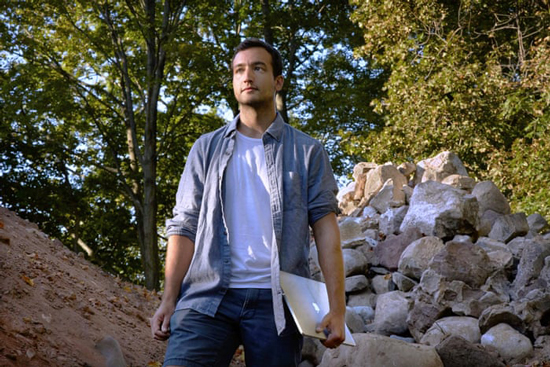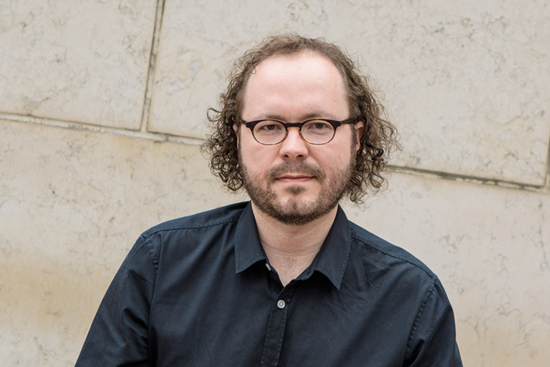‘Our minds can be hijacked’: the tech insiders who fear a smartphone dystopia (2)
Read the first part of the article

Loren Brichter
The designer who created the pull-to-refresh mechanism, first used to update Twitter feeds, is Loren Brichter, widely admired in the app-building community for his sleek and intuitive designs.
Now 32, Brichter says he never intended the design to be addictive – but would not dispute the slot machine comparison. “I agree 100%” he says. “I have two kids now and I regret every minute that I’m not paying attention to them because my smartphone has sucked me in.”
Brichter created the feature in 2009 for Tweetie, his startup, mainly because he could not find anywhere to fit the “refresh” button on his app. Holding and dragging down the feed to update seemed at the time nothing more than a “cute and clever” fix. Twitter acquired Tweetie the following year, integrating pull-to-refresh into its own app.
Since then the design has become one of the most widely emulated features in apps; the downward-pull action is, for hundreds of millions of people, as intuitive as scratching an itch.
Brichter says he is puzzled by the longevity of the feature. In an era of push notification technology, apps can automatically update content without being nudged by the user. “It could easily retire” he says. Instead it appears to serve a psychological function: after all, slot machines would be far less addictive if gamblers didn’t get to pull the lever themselves. Brichter prefers another comparison: that it is like the redundant “close door” button in some elevators with automatically closing doors. “People just like to push it.”
All of which has left Brichter, who has put his design work on the backburner while he focuses on building a house in New Jersey, questioning his legacy. “I’ve spent many hours and weeks and months and years thinking about whether anything I’ve done has made a net positive impact on society or humanity at all” he says. He has blocked certain websites, turned off push notifications, restricted his use of the Telegram app to message only with his wife and two close friends, and tried to wean himself off Twitter. “I still waste time on it” he confesses, “just reading stupid news I already know about.” He charges his phone in the kitchen, plugging it in at 7pm and not touching it until the next morning.
“Smartphones are useful tools” he says. “But they’re addictive. Pull-to-refresh is addictive. Twitter is addictive. These are not good things. When I was working on them, it was not something I was mature enough to think about. I’m not saying I’m mature now, but I’m a little bit more mature, and I regret the downsides.”
Not everyone in his field appears racked with guilt. The two inventors listed on Apple’s patent for “managing notification connections and displaying icon badges” are Justin Santamaria and Chris Marcellino. Both were in their early 20s when they were hired by Apple to work on the iPhone. As engineers, they worked on the behind-the-scenes plumbing for push-notification technology, introduced in 2009 to enable real-time alerts and updates to hundreds of thousands of third-party app developers. It was a revolutionary change, providing the infrastructure for so many experiences that now form a part of people’s daily lives, from ordering an Uber to making a Skype call to receiving breaking news updates.
But notification technology also enabled a hundred unsolicited interruptions into millions of lives, accelerating the arms race for people’s attention. Santamaria, 36, who now runs a startup after a stint as the head of mobile at Airbnb, says the technology he developed at Apple was not “inherently good or bad”. “This is a larger discussion for society” he says. “Is it all right to shut off my phone when I leave work? Is it all right if I don’t get right back to you? Is it all right that I’m not ‘liking’ everything that goes through my Instagram screen?”
His then colleague, Marcellino, agrees. “Honestly, at no point was I sitting there thinking: let’s hook people” he says. “It was all about the positives: these apps connect people, they have all these uses – ESPN telling you the game has ended, or WhatsApp giving you a message for free from your family member in Iran who doesn’t have a message plan.”
A few years ago, Marcellino, 33, left the Bay Area, and is now in the final stages of retraining to be a neurosurgeon. He stresses he is no expert on addiction, but says he has picked up enough in his medical training to know that technologies can affect the same neurological pathways as gambling and drug use. “These are the same circuits that make people seek out food, comfort, heat, sex” he says.
All of it, he says, is reward-based behaviour that activates the brain’s dopamine pathways. He sometimes finds himself clicking on the red icons beside his apps “to make them go away”, but is conflicted about the ethics of exploiting people’s psychological vulnerabilities. “It is not inherently evil to bring people back to your product” he says. “It’s capitalism.”

Roger McNamee
That, perhaps, is the problem. Roger McNamee, a venture capitalist who benefited from hugely profitable investments in Google and Facebook, has grown disenchanted with both companies, arguing that their early missions have been distorted by the fortunes they have been able to earn through advertising.
He identifies the advent of the smartphone as a turning point, raising the stakes in an arms race for people’s attention. “Facebook and Google assert with merit that they are giving users what they want” McNamee says. “The same can be said about tobacco companies and drug dealers.”
That would be a remarkable assertion for any early investor in Silicon Valley’s most profitable behemoths. But McNamee, 61, is more than an arms-length money man. Once an adviser to Mark Zuckerberg, 10 years ago McNamee introduced the Facebook CEO to his friend, Sheryl Sandberg, then a Google executive who had overseen the company’s advertising efforts. Sandberg, of course, became chief operating officer at Facebook, transforming the social network into another advertising heavyweight.
McNamee chooses his words carefully. “The people who run Facebook and Google are good people, whose well-intentioned strategies have led to horrific unintended consequences” he says. “The problem is that there is nothing the companies can do to address the harm unless they abandon their current advertising models.”
But how can Google and Facebook be forced to abandon the business models that have transformed them into two of the most profitable companies on the planet?
McNamee believes the companies he invested in should be subjected to greater regulation, including new anti-monopoly rules. In Washington, there is growing appetite, on both sides of the political divide, to rein in Silicon Valley. But McNamee worries the behemoths he helped build may already be too big to curtail. “The EU recently penalised Google $2.42bn for anti-monopoly violations, and Google’s shareholders just shrugged”, he says.
Rosenstein, the Facebook “like” co-creator, believes there may be a case for state regulation of “psychologically manipulative advertising”, saying the moral impetus is comparable to taking action against fossil fuel or tobacco companies. “If we only care about profit maximisation” he says, “we will go rapidly into dystopia.”
James Williams does not believe talk of dystopia is far-fetched. The ex-Google strategist who built the metrics system for the company’s global search advertising business, he has had a front-row view of an industry he describes as the “largest, most standardised and most centralised form of attentional control in human history”.
Williams, 35, left Google in 2016, and completed a PhD at Oxford University exploring the ethics of persuasive design. It is a journey that has led him to question whether democracy can survive the new technological age.
He says his epiphany came a few years ago, when he noticed he was surrounded by technology that was inhibiting him from concentrating on the things he wanted to focus on. “It was that kind of individual, existential realisation: what’s going on?” he says. “Isn’t technology supposed to be doing the complete opposite of this?”
That discomfort was compounded during a moment at work, when he glanced at one of Google’s dashboards, a multicoloured display showing how much of people’s attention the company had commandeered for advertisers. “I realised: this is literally a million people that we’ve sort of nudged or persuaded to do this thing that they weren’t going to otherwise do” he recalls.
He embarked on several years of independent research, much of it conducted while working part-time at Google. About 18 months in, he saw the Google memo circulated by Harris and the pair became allies, struggling to bring about change from within.
Williams and Harris left Google around the same time, and co-founded an advocacy group, Time Well Spent, that seeks to build public momentum for a change in the way big tech companies think about design. Williams finds it hard to comprehend why this issue is not “on the front page of every newspaper every day”.
“Eighty-seven percent of people wake up and go to sleep with their smartphones”, he says. The entire world now has a new prism through which to understand politics, and Williams worries the consequences are profound.
The same forces that led tech firms to hook users with design tricks, he says, also encourage those companies to depict the world in a way that makes for compulsive, irresistible viewing. “The attention economy incentivises the design of technologies that grab our attention” he says. “In so doing, it privileges our impulses over our intentions.”

James Williams
That means privileging what is sensational over what is nuanced, appealing to emotion, anger and outrage. The news media is increasingly working in service to tech companies, Williams adds, and must play by the rules of the attention economy to “sensationalise, bait and entertain in order to survive”.
In the wake of Donald Trump’s stunning electoral victory, many were quick to question the role of so-called “fake news” on Facebook, Russian-created Twitter bots or the data-centric targeting efforts that companies such as Cambridge Analytica used to sway voters. But Williams sees those factors as symptoms of a deeper problem.
It is not just shady or bad actors who were exploiting the internet to change public opinion. The attention economy itself is set up to promote a phenomenon like Trump, who is masterly at grabbing and retaining the attention of supporters and critics alike, often by exploiting or creating outrage.
Williams was making this case before the president was elected. In a blog published a month before the US election, Williams sounded the alarm bell on an issue he argued was a “far more consequential question” than whether Trump reached the White House. The reality TV star’s campaign, he said, had heralded a watershed in which “the new, digitally supercharged dynamics of the attention economy have finally crossed a threshold and become manifest in the political realm”.
Williams saw a similar dynamic unfold months earlier, during the Brexit campaign, when the attention economy appeared to him biased in favour of the emotional, identity-based case for the UK leaving the European Union. He stresses these dynamics are by no means isolated to the political right: they also play a role, he believes, in the unexpected popularity of leftwing politicians such as Bernie Sanders and Jeremy Corbyn, and the frequent outbreaks of internet outrage over issues that ignite fury among progressives.
All of which, Williams says, is not only distorting the way we view politics but, over time, may be changing the way we think, making us less rational and more impulsive. “We’ve habituated ourselves into a perpetual cognitive style of outrage, by internalising the dynamics of the medium” he says.
It is against this political backdrop that Williams argues the fixation in recent years with the surveillance state fictionalised by George Orwell may have been misplaced. It was another English science fiction writer, Aldous Huxley, who provided the more prescient observation when he warned that Orwellian-style coercion was less of a threat to democracy than the more subtle power of psychological manipulation, and “man’s almost infinite appetite for distractions”.
Since the US election, Williams has explored another dimension to today’s brave new world. If the attention economy erodes our ability to remember, to reason, to make decisions for ourselves – faculties that are essential to self-governance – what hope is there for democracy itself?
“The dynamics of the attention economy are structurally set up to undermine the human will” he says. “If politics is an expression of our human will, on individual and collective levels, then the attention economy is directly undermining the assumptions that democracy rests on.” If Apple, Facebook, Google, Twitter, Instagram and Snapchat are gradually chipping away at our ability to control our own minds, could there come a point at which democracy no longer functions?
“Will we be able to recognise it, if and when it happens?” Williams asks. “And if we can’t, then how do we know it hasn’t happened already?”
yogaesoteric
October 19, 2018
